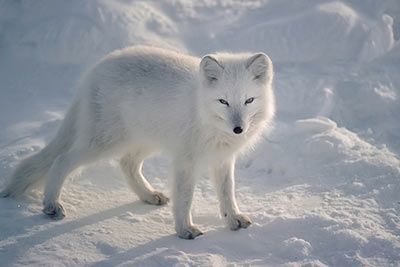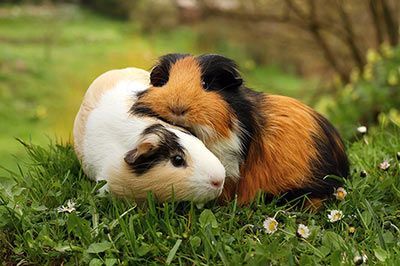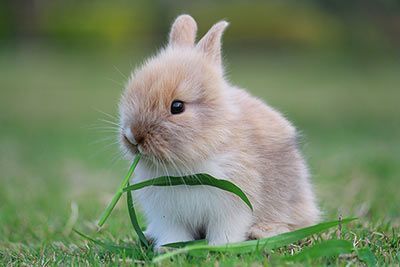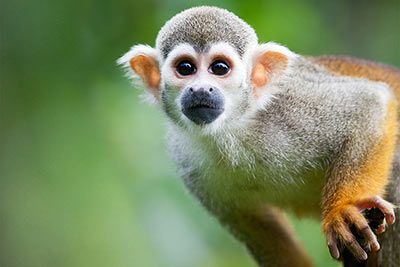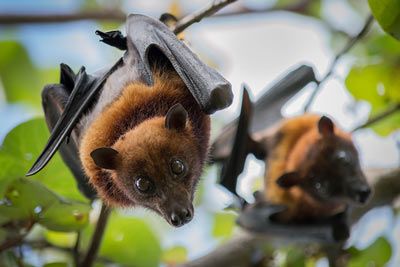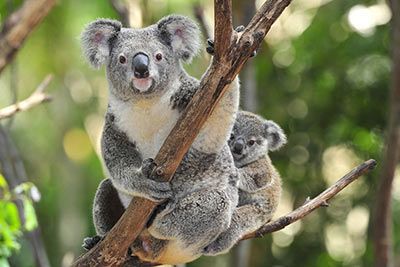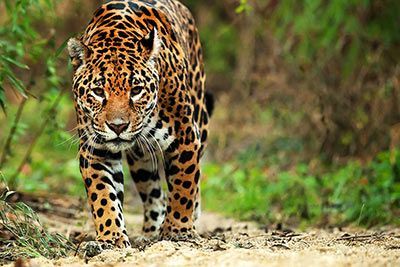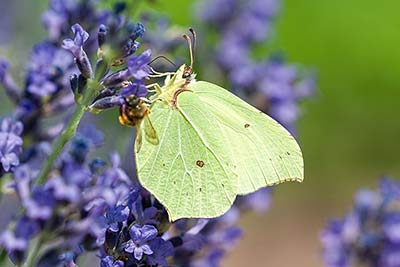Giraffe
Giraffe Facts
| Size | 14-19 feet (4.3-5.7 meters) |
| Speed | Up to 34 mph (55 km/h) |
| Weight | 1,830-2,645 pounds (830-1.200 kg) |
| Lifespan | 20-25 years |
| Food | Leaves, Buds, Flowers, Fruits |
| Predators | Lions, leopards, hyenas |
| Habitat | Southern Africa, Eastern Africa |
| Order | Even-toed ungulates |
| Family | Giraffidae |
| Scientific name | Giraffa camelopardalis |
| Characteristics | Tallest terrestrial animal (height), long neck, patches |
Main Characteristics
Giraffes are hoofed animals. They're the tallest animals in the world, reaching heights of up to 19 feet (5.7 meters). Their most striking features are their long neck and legs, the horn-like ossicones and their beautiful patches. They live in the savannahs of Africa. Their closest relatives are okapis, the forest giraffes.
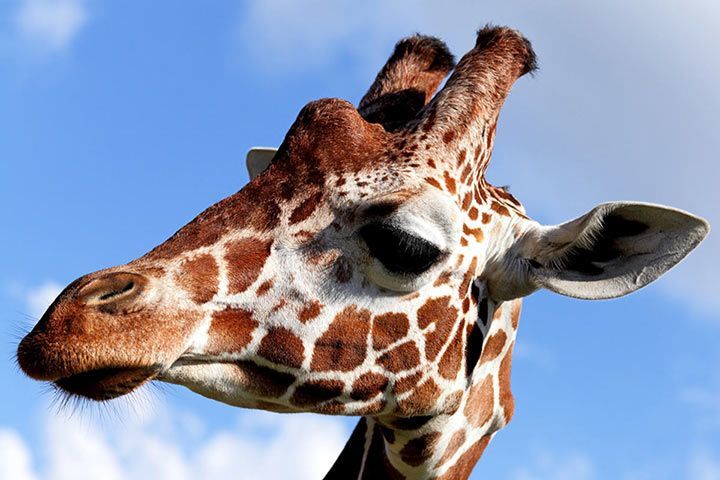
Species
There are six to nine species of giraffe - researchers are not yet sure about the exact number. They live in different regions of Africa and can be easily distinguished based on their color, patches and patterns. There are species with light, dark, ragged, square, small or large patches.
Distribution and Habitat
Giraffes live in Africa. They used to be widespread in North Africa too. Today they only exist south of the Sahara, in the south and east of the continent. Most live in wildlife parks. Their preferred habitat is the savanna and open forest landscapes.
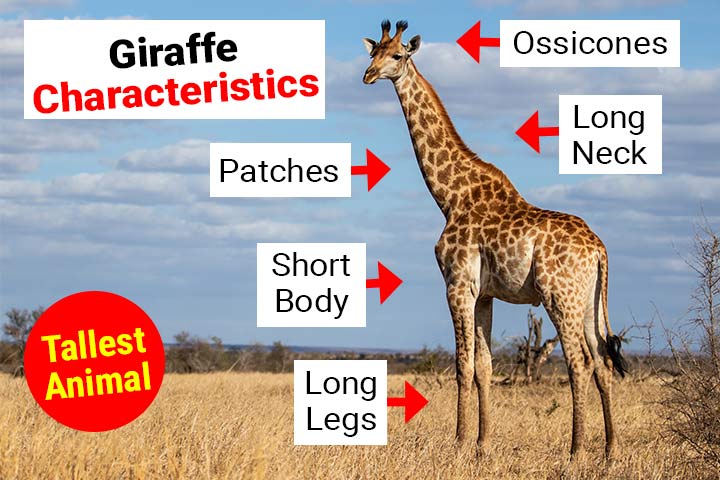
Life Style
Giraffes are diurnal animals. But that doesn't mean they sleep through the night. They only sleep about 30 minutes per night. There is a good reason for this: They have to constantly be on guard against predators. They spend the cool morning and evening hours eating. During the midday heat they rest in the shade and chew the cud.
Temperament and Nature
Are Giraffes Friendly or Dangerous?
Giraffes have a rather calm and gentle nature. They are not aggressive and do not bite. However, if they feel cornered, that can change. It doesn't matter whether it's lions, leopards, hyenas or humans. When giraffes are unable to find an escape route, they can become dangerous. They attack by launching powerful kicks with their hooves. This can be fatal for both predators and humans.
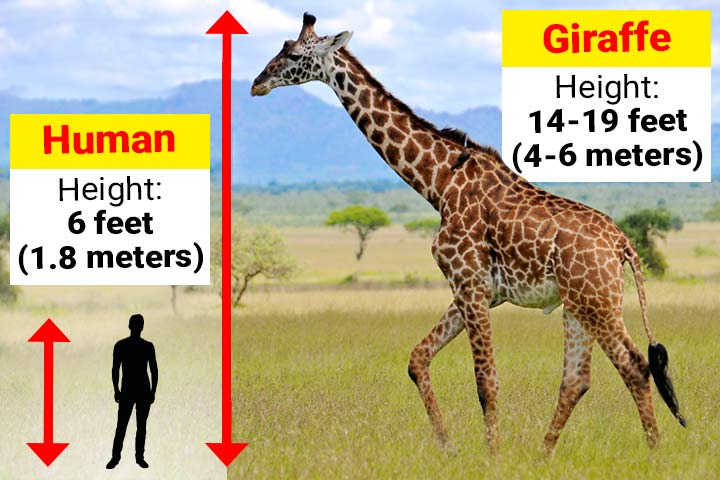
Anatomy and Appearance
Size and Weight
The height of giraffes can reach up to 19 feet (5.7 meters) when measured from their hooves to their horns. But not all giraffes grow that tall. Most bulls reach a height of between 15 and 18 feet (4.8 and 5.5 meters). The cows grow to a height of between (4.3 and 4.8 meters). In rare cases the bulls weigh 3,530 pounds (1,600 kg). On average it is 2,645 pounds (1,200 kg). And for the cows the average weight is 1,830 pounds (830 kg).
Body
Giraffes have a long neck and legs, but a very short body.
Ossicones
How do you tell a male from a female giraffe? Although the males are bigger than the females, their size alone is not enough to tell them apart. After all, two animals of different ages could stand next to each other. For example, a male cub next to his larger mother. Yet, there is an easy trick: Look at the ossicones. Adult bulls have thick, knobby horns without tufts of fur, while cows and young animals have thin horns with tufts of fur.
Neck
Giraffes have an incredibly elongated neck. It can grow up to 7.8 feet (2.4 meters) long. However, it is usually around 6 feet (1.8 meters). Its weight is considerable: it can weigh 500-600 pounds (226-272 kg). Surprisingly, they possess only seven cervical vertebrae. Just as many as humans do. However, their vertebrae are significantly bigger and longer compared to ours.
• Why Do Giraffes Have a Long Neck?
Until recently, it was believed that giraffes developed a long neck to reach leaves that grow higher. This was refuted in a 2017 study from the University of Wyoming and Pretoria. Scientists found out that the giraffe's ancestors didn't have a long neck as there were no tall trees that required them to grow one. The truth is: The longer the neck, the easier it is for them to defeat male rivals. Of course, the long neck still helps to reach more plants than with a short one.
Patches
Each giraffe has a unique patches. They serve multiple purposes:
• Camouflage
Up close, a giraffe's coat appears very noticeable. You may ask yourself: Is it tired of life? Such an unusual coat should be easy to detect for animals of prey. But this is only true from a short distance. From a further distance, the ungulates appear more like a tree or part of the landscape. The large patches actually serve as camouflage.
• Body Temperature
The patches help giraffes regulate their body temperature when it gets too hot. Large blood vessels sit beneath the light hair surrounding the dark patches. From there, small blood vessels branch off into the center of the patch. To cool off, the giraffe sends blood to the center of the patches. They work like "windows" through which the giraffe can release heat.
Tongue
• Appearance
The tongue is up to 20 inches (50 cm) long. Giraffes' tongues are dark in color - between blue, blue-gray and purple. Why? There is a simple reason. Similar to a natural sunscreen, the dark color provides protection from the sun's rays. Since the animals spend a lot of time eating and sticking out their tongues, this is very important for them.
• Purpose
Giraffes need their long tongues to eat. They wrap it around a branch and strip off the leaves. Spikes and thorns don't bother them. The tongue is completely insensitive to sharp leaves.
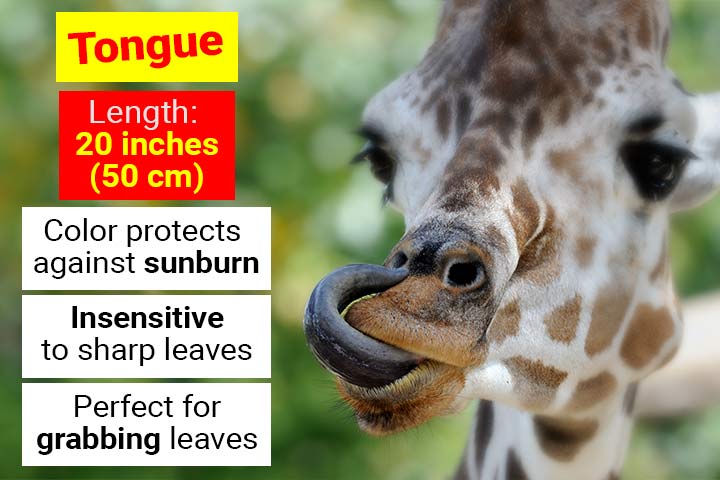
Diet
Giraffes are herbivores. They primarily feed on acacia leaves, which are very hard and spiky. Luckily, the tongue is insensitive. The ungulates can simply strip the leaves from the branches. Apart from acacia leaves, they also feed on flowers, fruits, buds, seeds and grass.
Food Needs
Giraffes need around 66-77 pounds (30-35 kg) of leaves per day. They spend 16-20 hours eating.
Ruminants
Giraffes are ruminants. In fact, they're the tallest ruminants in the world. They chew their food, swallow it and regurgitate it all the way back up their long throats to chew it again. They have four stomachs. Like cows.
Water Needs
Giraffes get 70% of their water needs from leaves. It is said that they can go without water for up to three weeks - longer than camels. If they get too thirsty, they drink at a waterhole.
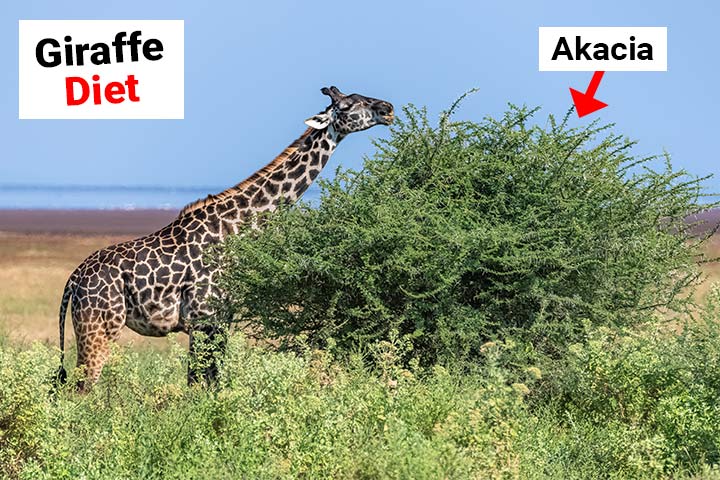
Behavior
Drinking
When it comes to drinking, giraffes have a very unique way of doing it. They spread their front legs apart, bend forward, and lower their long neck and head to reach the ground.
Sleeping
Giraffes only sleep 4-5 hours a day. They break up their sleeping time into multiple short naps. They often close their eyes between 2 a.m. and 4 a.m. They also enjoy short naps in the afternoon between 12 p.m. and 4 p.m. However, they don't sleep longer than of 35 minutes at a time. In fact, it is rare for adult animals to nap for more than 5 minutes at a time. They mainly doze while standing. The reason is clear: They can escape more quickly when a predator approaches.
Social Behavior
• Herd Animals
Giraffes aren't typical herd animals. The females and their young form small groups, but these are always reconstituted. The males are mostly solitary. Only the young ones form bachelor groups.
• Fighting Against Rivals
The adult males fight against each other to win over the females. They gain momentum with their neck and smash their head into the rival's neck.
Defense Against Predators
Giraffes prefer to stay in open landscapes. There they have a good overview of their surroundings – and possible attackers. When they see a predator approaching, they run away. If that's not possible, they defend themselves. They kick the attacker with their large, heavy hooves.
Giraffe Versus Lion - Who Would Win?
A healthy adult giraffe can kill a lion with one kick.
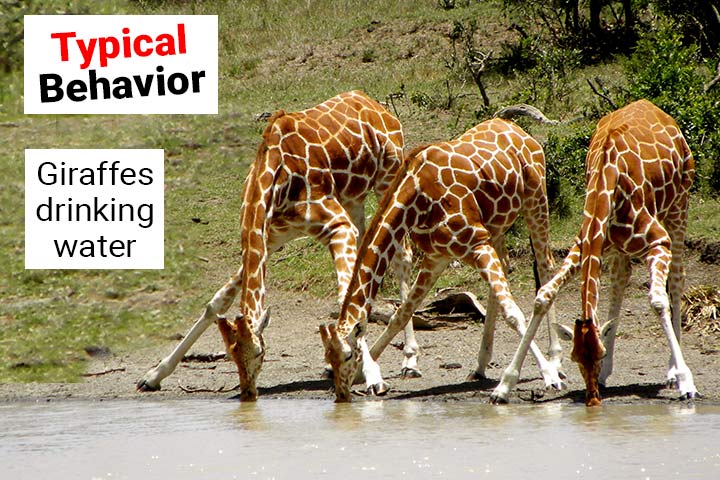
Senses and Abilities
Speed
Giraffes can run up to 34 mph (55 km/h). However, they can't trot, only walk or gallop. Their short bodies aren't made for trotting.
Sense of Sight
Giraffes have an excellent sense of sight. They even have the largest field of view of all mammals because their eyes are very wide apart. Their all-round vision is 360° and enables them to see everything without turning their head.
Sounds
For a long time, people used to think that giraffes didn't produce any sounds since their vocalizations are beyond the range of human hearing. However, they are able to communicate using infrasound waves that have a frequency below 20 Hz. These low-frequency sounds can travel long distances and allow them to stay connected with each other.
Jumping
Can giraffes jump? The answer to that is: yes and no. They wouldn't be able to leap over wide ditches like a horse. However, when they run with joy, they exhibit adorable little hops that are quite amusing. In their habitat, however, jumping is rarely necessary.
Blood Pressure
Giraffes have the highest blood pressure of all animals. Yet, they don't suffer from this. It's the other way round: It's very important to them. After all, the blood has to be pumped all the way up through the long neck and into the head.
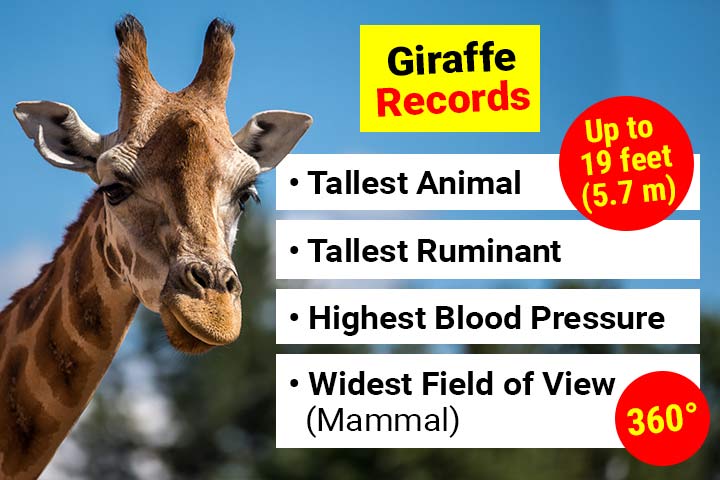
Life Expectancy
In the wild, giraffes live 20-25 years. The oldest giraffe in the world was called Twiga. She was 31 years and 9 months old. She lived in a zoo in Texas.
Enemies and Threats
Natural Enemies
Adult giraffes can defend themselves very well. They rarely have to fear an attacker. Things look different with the young animals. They're not that big and strong yet. When lions, leopards or hyenas approach, they are often in great danger.
People
For giraffes, hunting and habitat loss are the biggest threats. There used to be a lot of giraffes in the wild. Today most live in fenced-in game and safari parks - as an attraction for tourists.
How Many Giraffes Are Left?
Most giraffe species are considered endangered. According to a 2016 IUCN report, there are 68,000 giraffes left (as of February 2024, no more recent data available). In 1985 there were still over 150,000. This means that within 30 years the number of animals has decreased by 50%.
Importance for the Ecosystem
Giraffes eat leaves that other animals can't reach. They're like gardeners who carefully trim and prune trees, allowing them to flourish and produce fresh foliage. Giraffes also spread seeds through their feces. New trees emerge from them.
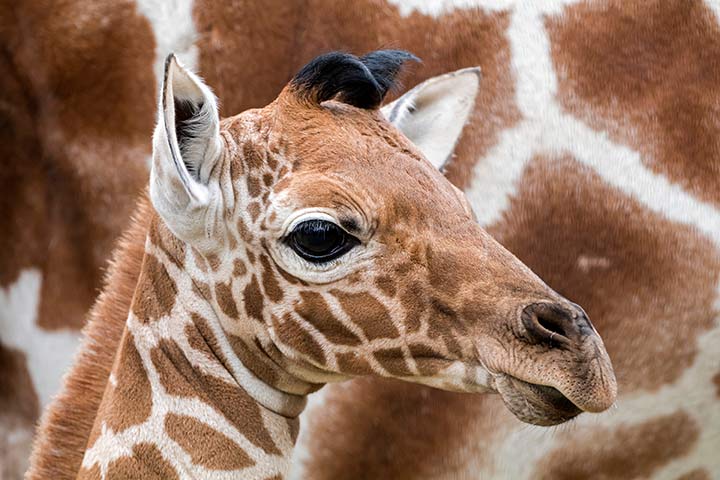
Reproduction
Giraffe babies are born after a gestation period of 14-15 months. With a body weight of 110 pounds (50 kg) they fall to the ground from a height of 6 feet (2 meters) without getting injured. Initially, the calf is a bit shaky on its legs, but it soon becomes adept at walking. When mother giraffes are worried about their young, they make barking sounds. Their offspring respond with a bleat, meow or moo. Young giraffes don't have an easy life. About 50% of them don't survive the first six months - because of predators.
The Giraffe Is Related To:
Animals in the Same Biome:
Related Articles:
Recommended Videos:













 Animal Eating Habits
Animal Eating Habits Symbiotic Animal Relationships
Symbiotic Animal Relationships